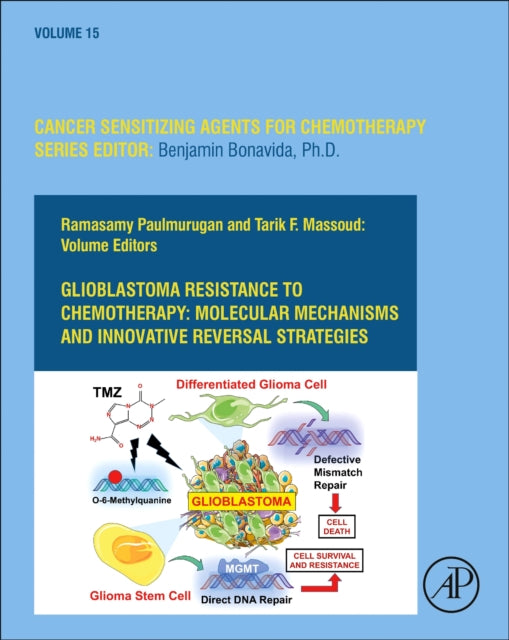Shulph Ink
Glioblastoma Resistance to Chemotherapy: Molecular Mechanisms and Innovative Reversal Strategies
Glioblastoma Resistance to Chemotherapy: Molecular Mechanisms and Innovative Reversal Strategies
YOU SAVE £8.44
- Condition: Brand new
- UK Delivery times: Usually arrives within 2 - 3 working days
- UK Shipping: Fee starts at £2.39. Subject to product weight & dimension
Bulk ordering. Want 15 or more copies? Get a personalised quote and bigger discounts. Learn more about bulk orders.
Couldn't load pickup availability
- More about Glioblastoma Resistance to Chemotherapy: Molecular Mechanisms and Innovative Reversal Strategies
Glioblastoma Resistance to Chemotherapy: Molecular Mechanisms and Innovative Reversal Strategies is a comprehensive book that discusses the science and clinical management of glioblastoma chemoresistance, including molecular mechanisms, experimental models, and targeted enhancement of p53 function to reverse chemoresistance. It is a valuable resource for cancer researchers, oncologists, neuro-oncologists, and other members of the biomedical field.
Format: Hardback
Length: 828 pages
Publication date: 25 June 2021
Publisher: Elsevier Science Publishing Co Inc
Glioblastoma, a devastating form of brain cancer, poses significant challenges due to its resistance to chemotherapy. In order to address this issue, Molecular Mechanisms and Innovative Reversal Strategies brings together a team of international experts who specialize in the science and clinical management of glioblastoma chemoresistance. This comprehensive book delves into various aspects of chemoresistance, including molecular mechanisms underlying this resistance, experimental models employed to study chemoresistance, and strategies to overcome chemoresistance in specific contexts.
Moreover, the book explores chemoresistance to drugs other than Temozolomide and discusses targeted enhancement of p53 function as a means to mitigate chemoresistance. As cancer researchers, oncologists, neuro-oncologists, and other members of the biomedical field, this book serves as a valuable resource for understanding the complexities of glioblastoma therapy resistance and developing innovative reversal strategies.
Understanding the molecular mechanisms of chemoresistance in glioblastoma is crucial for developing effective treatment strategies. The book discusses various molecular pathways that contribute to chemoresistance, such as the activation of signaling pathways, overexpression of drug efflux pumps, and alterations in tumor microenvironment. By gaining insights into these mechanisms, researchers can identify potential targets for therapeutic intervention.
Experimental models play a vital role in studying chemoresistance in glioblastoma. The book provides detailed descriptions of experimental models used to investigate the mechanisms of chemoresistance, including cell line models, animal models, and patient-derived xenograft models. These models allow researchers to test the efficacy of various therapeutic agents and identify potential biomarkers that can predict chemoresistance.
One of the significant challenges in treating glioblastoma is chemoresistance to drugs other than Temozolomide. The book discusses various strategies to overcome chemoresistance to drugs other than Temozolomide, such as combination therapy, targeted therapy, and immunotherapy. Combination therapy involves the use of multiple drugs or therapies in combination to enhance their effectiveness and overcome drug resistance. Targeted therapy involves the use of drugs or therapies that specifically target the molecular pathways or proteins involved in chemoresistance. Immunotherapy utilizes the body's immune system to target and destroy cancer cells.
In addition to these therapeutic strategies, the book also emphasizes the importance of targeted enhancement of p53 function as a means to mitigate chemoresistance. p53 is a tumor suppressor protein that plays a crucial role in regulating cell growth and survival. By enhancing the function of p53, researchers can increase the sensitivity of glioblastoma cells to chemotherapy and improve their overall response to treatment.
Mitigating chemoresistance by targeted enhancement of p53 function is a promising approach for improving the outcomes of glioblastoma therapy. The book discusses various methods and techniques used to enhance p53 function, such as gene therapy, small molecule drugs, and protein-based therapies. Gene therapy involves the introduction of genetic material into cells to modify their function. Small molecule drugs target specific molecules or pathways involved in chemoresistance. Protein-based therapies involve the use of proteins or peptides to modulate the activity of p53 or other proteins involved in chemoresistance.
Furthermore, the book provides valuable insights into the clinical management of glioblastoma patients who are resistant to chemotherapy. It discusses the importance of early diagnosis, personalized treatment plans, and close monitoring of patients during therapy. It also highlights the role of patient education and support in improving patient outcomes and quality of life.
In conclusion, Glioblastoma Resistance to Chemotherapy: Molecular Mechanisms and Innovative Reversal Strategies is a comprehensive and authoritative book that provides current knowledge from an international team of experts on the science and clinical management of glioblastoma chemoresistance. By exploring molecular mechanisms, experimental models, chemoresistance to drugs other than Temozolomide, and targeted enhancement of p53 function, this book offers valuable insights into the complexities of glioblastoma therapy resistance and provides innovative reversal strategies for improving patient outcomes. As cancer researchers, oncologists, neuro-oncologists, and other members of the biomedical field, this book is a valuable resource for understanding the challenges of glioblastoma therapy and developing effective treatment strategies.
Weight: 1812g
Dimension: 226 x 280 x 46 (mm)
ISBN-13: 9780128215678
This item can be found in:
UK and International shipping information
UK and International shipping information
UK Delivery and returns information:
- Delivery within 2 - 3 days when ordering in the UK.
- Shipping fee for UK customers from £2.39. Fully tracked shipping service available.
- Returns policy: Return within 30 days of receipt for full refund.
International deliveries:
Shulph Ink now ships to Australia, Belgium, Canada, France, Germany, Ireland, Italy, India, Luxembourg Saudi Arabia, Singapore, Spain, Netherlands, New Zealand, United Arab Emirates, United States of America.
- Delivery times: within 5 - 10 days for international orders.
- Shipping fee: charges vary for overseas orders. Only tracked services are available for most international orders. Some countries have untracked shipping options.
- Customs charges: If ordering to addresses outside the United Kingdom, you may or may not incur additional customs and duties fees during local delivery.


